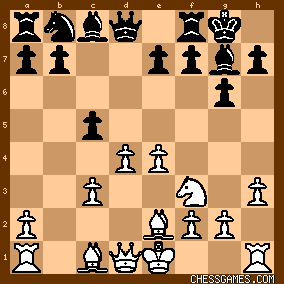| Nov-25-05 | | alicefujimori: Again...another game that deserves a lot more posts and discussions. Who would have thought of playing 9...b5 in that position. |
|
| Apr-27-06 | | Bob726: what about bxb5?
|
|
| Sep-16-06 | | babywizard: 10.Bxb5 cxd4 followed by Qa5 |
|
| Mar-03-07 | | The Chess Express: Isn’t the position after 24. Bxb6 winning for white? |
|
| Sep-10-08 | | sallom89: 9...b5 is amazing. |
|
| Oct-29-09 | | The Chess Express: Well, if 9...b5 does anything more than give white a pawn I don't see it. Struggling for a draw in a pawn down endgame doesn't seem like much fun to me. |
|
| Feb-01-10 | | KingG: Kasparov and Kramnik analysing this game: http://www.youtube.com/watch?v=W2T8.... Unfortunately it's in Russian. |
|
Feb-01-10
 | | chancho: Don't understand what they are saying in Russian, but Gazza appears to be irritated at some points in that post mortem analysis. Maybe that's how he rolls day to day, with the kind of stress that is similar to a volcano erupting violently. Kramnik however sounds kind of tranquil and matter of factly while discussing the positions on the board. And why does Kasparov keep looking to the flunky on his right? Is he trying to find some kind of solace from that guy or something? Sheesh! |
|
| Feb-01-10 | | KingG: <chancho> I've noticed he does that a lot in the post-mortem. Check out the video I posted of him analysing with Radjabov: Radjabov vs Kasparov, 2003. I think he's definitely one of these people that wants to win the adjournment, even if he didn't win the game. |
|
| Feb-01-10 | | DCP23: <chancho: And why does Kasparov keep looking to the flunky on his right?> The flunky in question is none other than Kasparov's trainer Dokhoyan, who works with Karjakin now. |
|
| Feb-01-10 | | Mr. Bojangles: Kasparov is a very animated individual, Kramnik is as cool as ice. I wonder what it would take for Kramnik to lose his cool and explode? |
|
Feb-01-10
 | | chancho: <DCP23> I really did not care to know who he was, but thanks. |
|
| Feb-01-10 | | KingG: <I think he's definitely one of these people that wants to win the adjournment, even if he didn't win the game.> I meant post-mortem instead of adjournment of course. |
|
| Feb-08-11 | | Eyal: According to the TWIC report (http://www.chess.co.uk/twic/wijk12....), Kasparov came up with 9...b5!? after 40 minutes of thought. 8.h3 is a rare move, and Kasparov evidently wasn't ready for that and wanted to avoid probable home prep by Kramnik in response to the more usual moves, 9...Nc6 or 9...b6 (in comparison with …b6, …b5 allows the knight maneuver via b6). It certainly doesn’t "just lose a pawn" – taking it immediately would be bad – 10.Bxb5 cxd4 11.Nxd4 (11.cxd4?? Qa5+ winning the bishop) 11…Qa5 aiming for e5. Eventually Kramnik manages to win the pawn on move 24, after some clever and elaborate maneuvering, but by then, with all the piece exchanges and the liquidation of the Q-side pawns, it’s not enough to win. |
|
| Feb-09-11 | | Hesam7: <Now a few words about another old variation. 'The attempt to prevent the unpleasant pin (...Bg4) by <8 h3> leads to the loss of an important tempo,' write Botvinnik and Estrin, citing 8...Nc6 9 Be3 O-O 10 Qd2 Qa5 11 Bc4 cxd4 12 cxd4 Qxd2+ 13 Kxd2 Rd8 with a good endgame for Black (Vidmar - Alekhine, Nottingham 1936). True 64 years later, when Kramnik played this against me, I discovered that the slow move of the rook's pawn was not without venom. It can truly be said that that the new is merely the old that has been well forgotten! <8...O-O 9 Be2>

click for larger view<9...Nc6!>
Against Kramnik (Wijk aan Zee 2000) I played, so to speak, at sight: 9...b5!? 10 Be3 Bb7 11 Qd3 cxd4 (the immediate 11...Nd7 12 O-O Nb6 is probably stronger) 12 cxd4 Nd7 13 O-O Nb6 14 Qb1! Na4! (against the mechanical 14...a6 there is the unpleasant reply 15 a4!) 15 Qxb5 Nc3 16 Qxb7 Nxe2+ 17 Kh1 Nxd4 18 Rad1 e5 19 Nxe5 Bxe5 20 f4! (in the rook endgame after 20 Bxd4 Bxd4 21 Qb4 Rb8 22 Qxd4 Qxd4 23 Rxd4 Rb2 24 Ra4 Rc8 25 Rxa7 Rcc2 a draw is inevitable) 20...Bg7 21 e5 Qb6! 22 Qxb6 axb6 23 Bxd4 Rxa2 24. Bxb6 Re8! Preparing f7-f6 with further exchanges. By accurate play Black soon reached the heaven of a draw. <10 Be3 cxd4 11 cxd4 f5!> A typical Gruenfeld undermining move: after 12 exf5 Qa5+ or 12 e5 Be6 Black has quite good counter-chances, while in the event of 12 Bc4+ Kh8 13 e5 the flank blow 13...b5! is now strong.> Revolution in the 70s, Garry Kasparov. |
|
Oct-20-14
 | | plang: After the conventional 14..a6 Kramnik would have had an advantage after 15 a4..bxa 16 Ra2 or 16 d5..Bxa1 17 Qxa1 with excellent compensation for the exchange. 15 Qxb5 led eventually to the win of a pawn but offered limited winning chances; 15 Rc1 would have been an alternative continuation to try and maintain an initiative. It was important for Black to retain his dark-squared bishop with 20..Bg7 as after the alternative 20..Qb6? 21 Qxb6..axb 22 fxe..Ne6 23 Bxb6 (or 23 Rd7) Black's king is vulnerable. Perhaps Kramnik could have tried 25 Rd6 but after 25..g5 26 g3..h5 27 h4..g4 Black should hold. Kasparov had to avoid 34..Rc2+? 35 Kf3..Rc3+ 36 Ke4..Rxh3 37 f6!..hxg 38 Kf5..Rh6 39 Kxg5..Rh6 40 Kg6 and wins. |
|
| May-13-25 | | nummerzwei: After 10.Bxb5?, Black should play 10...Qa5 ∓ rather than 10...cxd4?! allowing 11.Nxd4!?, which is not that great for Black. |
|





